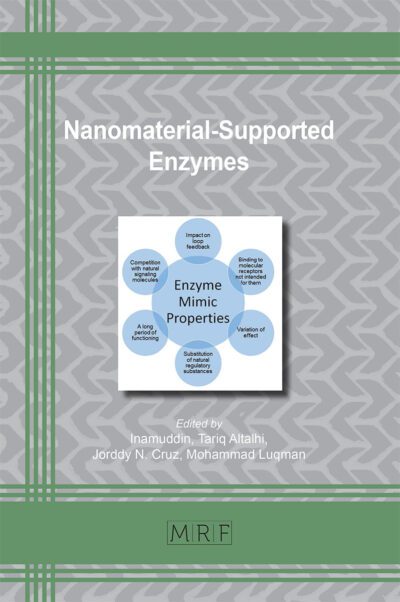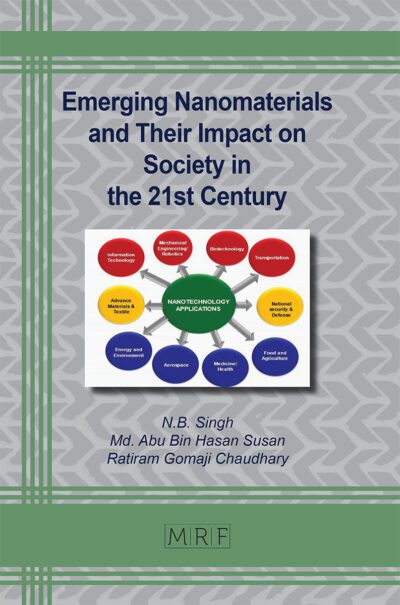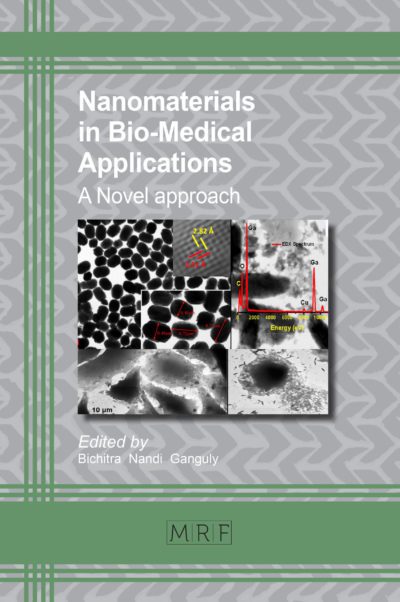Morphological and crystallinity properties of bacterial nanocellulose foam reinforced by copper oxide nanoparticles
JIBRIL Maulana, HERU Suryanto, AMINNUDIN Aminnudin, JOSEPH Selvi Binoj, MAVINKERE Rangappa Sanjay, SUCHART Siengchin, UUN Yanuhar
Abstract. Bacterial cellulose (BC) is a material with advantages such as high purity, mechanical strength, crystallinity, and unique physical properties while being biodegradable. However, in order to improve specific characteristics, cellulose should be combined with other materials. One type of metal that can be applied as an additive in bacterial nanocellulose (BNC) networks is copper oxide nanoparticles (CuO-NPs). Copper has great potential for application as a cellulose tissue filler. Cetyl Trimethyl Ammonium Bromide (CTAB) is required to assist in the distribution and bonding of BC. This research provided the use of BC, which is produced from pineapple peel. Afterward, the BC was homogenized with High-pressure homogenization to produce BNC, mixed with varied CuO-NPs (0, 0.25, 0.5, 1, 1.5, 2%). As a result, a BNC/CuO-NPs nanocomposite is synthesized. CTAB can successfully homogenize the distribution of CuO-NPs, according to morphological investigations. The addition of CTAB and CuO-NPs toward the crystallinity increased the intensity at diffraction angles of 21.3, 35.5, and 38.6, thus according to XRD observations.
Keywords
Bacterial Cellulose, Crystallinity, Copper Oxide, Foam, Nanoparticles
Published online 4/25/2025, 7 pages
Copyright © 2025 by the author(s)
Published under license by Materials Research Forum LLC., Millersville PA, USA
Citation: JIBRIL Maulana, HERU Suryanto, AMINNUDIN Aminnudin, JOSEPH Selvi Binoj, MAVINKERE Rangappa Sanjay, SUCHART Siengchin, UUN Yanuhar, Morphological and crystallinity properties of bacterial nanocellulose foam reinforced by copper oxide nanoparticles, Materials Research Proceedings, Vol. 53, pp 298-304, 2025
DOI: https://doi.org/10.21741/9781644903575-29
The article was published as article 29 of the book Decarbonization Technology
![]() Content from this work may be used under the terms of the Creative Commons Attribution 3.0 license. Any further distribution of this work must maintain attribution to the author(s) and the title of the work, journal citation and DOI.
Content from this work may be used under the terms of the Creative Commons Attribution 3.0 license. Any further distribution of this work must maintain attribution to the author(s) and the title of the work, journal citation and DOI.
References
[1] Z. Mohammedi, Structure, properties and medical advances for biocellulose applications: A review, Am. J. Polym. Sci. Technol., 3 (2017) 89-96. https://doi.org/10.11648/j.ajpst.20170305.12
[2] M. Zeng, A. Laromaine, and A. Roig, Bacterial cellulose films: influence of bacterial strain and drying route on film properties, Cellulose, 21 (2014) 4455–4469. https://doi.org/10.1007/s10570-014-0408-y
[3] H. Pawignya, Pembuatan protein sel tunggal dari limbah nanas dengan proses fermentasi, Pros. Semin. Nas. Tek. Kim., (2011) A05-1-A05-5.
[4] L.C. De L. Novaes, V. De C.S. Ebinuma, P.G. Mazzola, and A.P. Júnior, Polymer-based alternative method to extract bromelain from pineapple peel waste, Biotechnol. Appl. Biochem., 60 (2013) 527–535. https://doi.org/10.1002/bab.1121
[5] H. J. Song, H. Li, J. H. Seo, M. J. Kim, and S. J. Kim, Pilot-scale production of bacterial cellulose by a spherical type bubble column bioreactor using saccharified food wastes, Korean J. Chem. Eng., 26 (2009) 141–146. https://doi.org/10.1007/s11814-009-0022-0
[6] T. Mahsuli, A. Larasati, A. Aminnudin, and J. Maulana, Effect of the homogenization process on titanium oxide-reinforced nanocellulose composite membranes, J. Mech. Eng. Sci. Technol., 7 (2023) 137-146. https://doi.org/10.17977/um016v7i22023p137
[7] T.A. Agustin and A. Putra, The effect of addition of polyethylene glycol (PEG) on biodegradable plastic based on bacterial cellulose from coconut water (Coconus nucifera), Int. J. Progress. Sci. Technol., 17 (2019) 50–57. [Online]. Available: http://ijpsat.ijsht-journals.org/index.php/ijpsat/article/view/1398/742.
[8] M. Muhajir, H. Suryanto, Y.R.A. Pradana, and U. Yanuhar, Effect of homogenization pressure on bacterial cellulose membrane characteristic made from pineapple peel waste, J. Mech. Eng. Sci. Technol., 6 (2022) 34–39. https://doi.org/10.17977/um016v6i12022p034
[9] A.Y. Booshehri, R. Wang, and R. Xu, Simple method of deposition of CuO nanoparticles on a cellulose paper and its antibacterial activity, Chem. Eng. J., 262 (2015) 999–1008. https://doi.org/10.1016/j.cej.2014.09.096
[10] N. Kawee, N. T. Lam, and P. Sukyai, Homogenous isolation of individualized bacterial nanofibrillated cellulose by high-pressure homogenization, Carbohydr. Polym., 179 (2018) 394–401. https://doi.org/10.1016/j.carbpol.2017.09.101
[11] N. Daels, S. De Vrieze, I. Sampers, B. Decostere, P. Westbroek, A. Dumoulin, P. Dejans, K. De Clerck, S.W.H. Van Hulle, Potential of a functionalised nanofibre microfiltration membrane as an antibacterial water filter, Desalination, 275 (2011) 285–290. https://doi.org/10.1016/j.desal.2011.03.012
[12] J. Nemoto, T. Saito, and A. Isogai, Simple freeze-drying procedure for producing nanocellulose aerogel-containing, high-performance air filters, Appl. Mater. interfaces, (2015). https://doi.org/10.1021/acsami.5b05841
[13] K. Li, L.N. Skolrood, T. Aytug, H. Tekinalp, and S. Ozcan, Strong and tough cellulose nanofibrils composite films: Mechanism of synergetic effect of hydrogen bonds and ionic interactions, ACS Sustain. Chem. Eng., 7 (2019) 14341–14346. https://doi.org/10.1021/acssuschemeng.9b03442
[14] W. Wu, L. Zhang, X. Zhai, C. Liang, and K. Yu, Preparation and photocatalytic activity analysis of nanometer TiO2 modified by surfactant, Nanomater. Nanotechnol., 8 (2018). https://doi.org/10.1177/1847980418781973
[15] H. Suryanto, A. Aminnudin, R.D. Bintara, A.F. Putra, F.M. Nashrullah, J.S. Binoj, and N. Panicker, Analysis of structure and functional group of filament product-based PLA/nanographite nanocomposite, J. Mech. Eng. Sci. Technol., 7 (2023) 129-136. https://doi.org/10.17977/um016v7i22023p129
[16] H.I. Lee, H.J. Park, Y.K. Park, J.Y. Hur, J.K. Jeon, and J.M. Kim, Synthesis of highly stable mesoporous aluminosilicates from commercially available zeolites and their application to the pyrolysis of woody biomass, Catal. Today, 132 (2008) 68–74. https://doi.org/10.1016/j.cattod.2007.12.029
[17] S.H. Yoon, M. Kang, W. Il Park, and H.J. Jin, Electrically conductive polymeric membranes by incorporation of carbon nanotubes, Mol. Cryst. Liq. Cryst., 464 (2007) 103/[685]-108/[690]. https://doi.org/10.1080/15421400601030449
[18] H. Suryanto, U. Yanuhar, J. Maulana, and Y.R.A. Pradana, Effect of addition surfactant on properties of bacterial cellulose based composite foam reinforced by copper oxide nanoparticle, J. Eng. Sci. Technol. Rev., 14 (2021) 102–106. https://doi.org/10.25103/jestr.146.11
[19] A. Vazquez, M.L. Foresti, P. Cerrutti, and M. Galvagno, Bacterial cellulose from simple and low cost production media by Gluconacetobacter xylinus, J. Polym. Environ., 21 (2013) 545–554. https://doi.org/10.1007/s10924-012-0541-3
[20] L. Chen, D. Zhang, J. Chen, H. Zhou, and H. Wan, The use of CTAB to control the size of copper nanoparticles and the concentration of alkyl thiols on their surfaces, Mater. Sci. Eng. A, 415 (2006) 156–161. https://doi.org/10.1016/j.msea.2005.09.060
[21] Z. Singh and I. Singh, CTAB surfactant assisted and high pH nano-formulations of CuO nanoparticles pose greater cytotoxic and genotoxic effects, Sci. Rep., 9 (2019) 1–13. https://doi.org/10.1038/s41598-019-42419-z
[22] H. Almasi, L. Mehryar, and A. Ghadertaj, Characterization of CuO-bacterial cellulose nanohybrids fabricated by in-situ and ex-situ impregnation methods, Carbohydr. Polym., 222 (2019). https://doi.org/10.1016/j.carbpol.2019.114995














